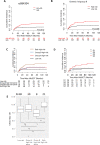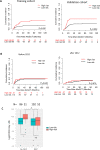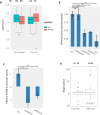Polymorphisms in CXCR3 ligands predict early CXCL9 recovery and severe chronic GVHD
- PMID: 33640906
- PMCID: PMC7914250
- DOI: 10.1038/s41408-021-00434-2
Polymorphisms in CXCR3 ligands predict early CXCL9 recovery and severe chronic GVHD
Abstract
Chronic graft-versus-host disease (cGVHD) is a major cause of mortality and morbidity after allogeneic stem cell transplantation (alloSCT). The individual risk of severe cGVHD remains difficult to predict and may involve CXCR3 ligands. This study investigated the role of single-nucleotide polymorphisms (SNPs) of CXCL4, CXCL9, CXCL10, and CXCL11, and their day +28 serum levels, in cGVHD pathogenesis. Eighteen CXCR3 and CXCL4, CXCL9-11 SNPs as well as peri-transplant CXCL9-11 serum levels were analyzed in 688 patients without (training cohort; n = 287) or with statin-based endothelial protection cohort (n = 401). Clinical outcomes were correlated to serum levels and SNP status. Significant polymorphisms were further analyzed by luciferase reporter assays. Findings were validated in an independent cohort (n = 202). A combined genetic risk comprising four CXCR3 ligand SNPs was significantly associated with increased risk of severe cGVHD in both training cohort (hazard ratio (HR) 2.48, 95% confidence interval (CI) 1.33-4.64, P = 0.004) and validation cohort (HR 2.95, 95% CI 1.56-5.58, P = 0.001). In reporter assays, significantly reduced suppressive effects of calcineurin inhibitors in constructs with variant alleles of rs884304 (P < 0.001) and rs884004 (P < 0.001) were observed. CXCL9 serum levels at day +28 after alloSCT correlated with both genetic risk and risk of severe cGVHD (HR 1.38, 95% CI 1.10-1.73, P = 0.006). This study identifies patients with high genetic risk to develop severe cGVHD.
Conflict of interest statement
The authors declare no competing interests.
Figures



Similar articles
-
CXCL9 Predicts Severity at the Onset of Chronic Graft-versus-host Disease.Transplantation. 2020 Nov;104(11):2354-2359. doi: 10.1097/TP.0000000000003108. Transplantation. 2020. PMID: 31929430
-
Interleukin-27 and IFNγ regulate the expression of CXCL9, CXCL10, and CXCL11 in hepatitis.J Mol Med (Berl). 2015 Dec;93(12):1355-67. doi: 10.1007/s00109-015-1319-6. Epub 2015 Jul 23. J Mol Med (Berl). 2015. PMID: 26199110
-
Strong overexpression of CXCR3 axis components in childhood inflammatory bowel disease.Inflamm Bowel Dis. 2010 Nov;16(11):1882-90. doi: 10.1002/ibd.21312. Inflamm Bowel Dis. 2010. PMID: 20848514
-
Review of Genetic Variation as a Predictive Biomarker for Chronic Graft-Versus-Host-Disease After Allogeneic Stem Cell Transplantation.Front Immunol. 2020 Oct 19;11:575492. doi: 10.3389/fimmu.2020.575492. eCollection 2020. Front Immunol. 2020. PMID: 33193367 Free PMC article.
-
CXCR3 Ligands in Cancer and Autoimmunity, Chemoattraction of Effector T Cells, and Beyond.Front Immunol. 2020 May 29;11:976. doi: 10.3389/fimmu.2020.00976. eCollection 2020. Front Immunol. 2020. PMID: 32547545 Free PMC article. Review.
Cited by
-
Current Definitions and Clinical Implications of Biomarkers in Graft-versus-Host Disease.Transplant Cell Ther. 2022 Oct;28(10):657-666. doi: 10.1016/j.jtct.2022.07.008. Epub 2022 Jul 11. Transplant Cell Ther. 2022. PMID: 35830932 Free PMC article. Review.
-
EASIX for Prediction of Outcome in Hospitalized SARS-CoV-2 Infected Patients.Front Immunol. 2021 Jun 23;12:634416. doi: 10.3389/fimmu.2021.634416. eCollection 2021. Front Immunol. 2021. PMID: 34248931 Free PMC article.
-
[Clinical study of the cytokine panel in the diagnosis of ocular chronic graft-versus-host disease].Zhonghua Xue Ye Xue Za Zhi. 2024 Mar 14;45(3):242-248. doi: 10.3760/cma.j.cn121090-20231031-00242. Zhonghua Xue Ye Xue Za Zhi. 2024. PMID: 38716595 Free PMC article. Chinese.
-
Toward a Better Understanding of the Atypical Features of Chronic Graft-Versus-Host Disease: A Report from the 2020 National Institutes of Health Consensus Project Task Force.Transplant Cell Ther. 2022 Aug;28(8):426-445. doi: 10.1016/j.jtct.2022.05.038. Epub 2022 May 31. Transplant Cell Ther. 2022. PMID: 35662591 Free PMC article. Review.
-
Identification of single nucleotide polymorphisms (SNPs) associated with chronic graft-versus-host disease in patients undergoing allogeneic hematopoietic cell transplantation.Support Care Cancer. 2023 Sep 21;31(10):587. doi: 10.1007/s00520-023-08044-3. Support Care Cancer. 2023. PMID: 37731134 Free PMC article.
References
Publication types
MeSH terms
Substances
Grants and funding
LinkOut - more resources
Full Text Sources
Other Literature Sources
Research Materials
Miscellaneous

